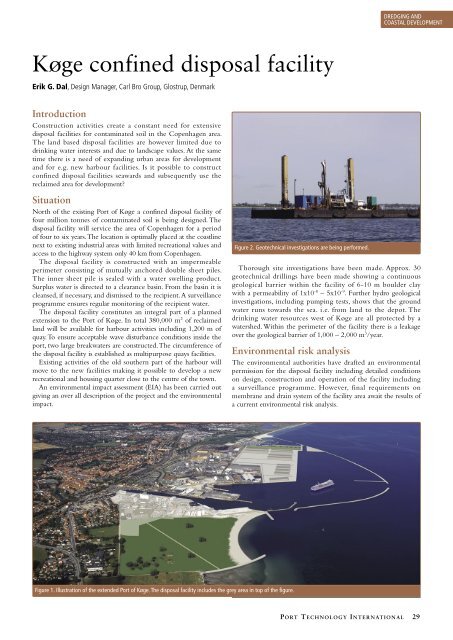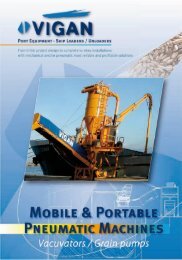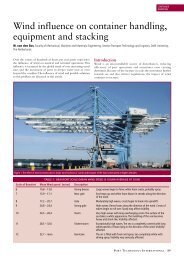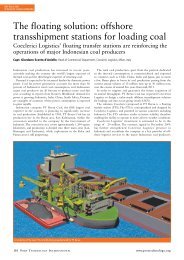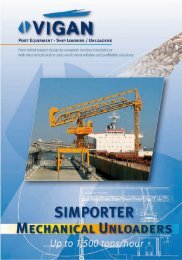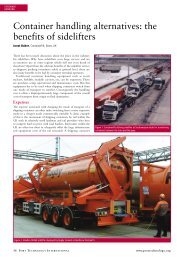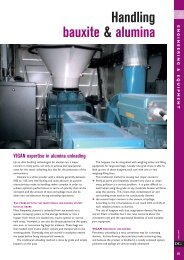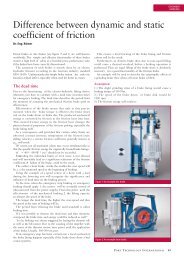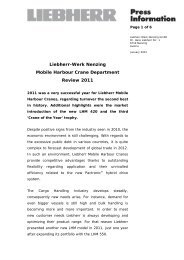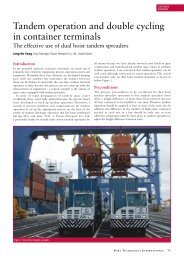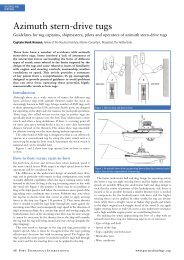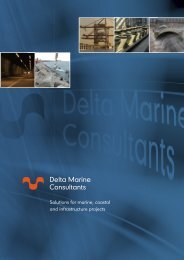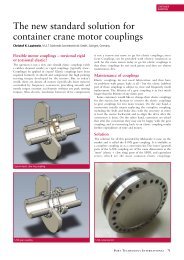Køge confined disposal facility - Port Technology International
Køge confined disposal facility - Port Technology International
Køge confined disposal facility - Port Technology International
Create successful ePaper yourself
Turn your PDF publications into a flip-book with our unique Google optimized e-Paper software.
DREDGING ANDCOASTAL DEVELOPMENT<strong>Køge</strong> <strong>confined</strong> <strong>disposal</strong> <strong>facility</strong>Erik G. Dal, Design Manager, Carl Bro Group, Glostrup, DenmarkIntroductionConstruction activities create a constant need for extensive<strong>disposal</strong> facilities for contaminated soil in the Copenhagen area.The land based <strong>disposal</strong> facilities are however limited due todrinking water interests and due to landscape values. At the sametime there is a need of expanding urban areas for developmentand for e.g. new harbour facilities. Is it possible to construct<strong>confined</strong> <strong>disposal</strong> facilities seawards and subsequently use thereclaimed area for development?SituationNorth of the existing <strong>Port</strong> of <strong>Køge</strong> a <strong>confined</strong> <strong>disposal</strong> <strong>facility</strong> offour million tonnes of contaminated soil is being designed. The<strong>disposal</strong> <strong>facility</strong> will service the area of Copenhagen for a periodof four to six years. The location is optimally placed at the coastlinenext to existing industrial areas with limited recreational values andaccess to the highway system only 40 km from Copenhagen.The <strong>disposal</strong> <strong>facility</strong> is constructed with an impermeableperimeter consisting of mutually anchored double sheet piles.The inner sheet pile is sealed with a water swelling product.Surplus water is directed to a clearance basin. From the basin it iscleansed, if necessary, and dismissed to the recipient. A surveillanceprogramme ensures regular monitoring of the recipient water.The <strong>disposal</strong> <strong>facility</strong> constitutes an integral part of a plannedextension to the <strong>Port</strong> of <strong>Køge</strong>. In total 380,000 m 2 of reclaimedland will be available for harbour activities including 1,200 m ofquay. To ensure acceptable wave disturbance conditions inside theport, two large breakwaters are constructed. The circumference ofthe <strong>disposal</strong> <strong>facility</strong> is established as multipurpose quays facilities.Existing activities of the old southern part of the harbour willmove to the new facilities making it possible to develop a newrecreational and housing quarter close to the centre of the town.An environmental impact assessment (EIA) has been carried outgiving an over all description of the project and the environmentalimpact.Figure 2. Geotechnical investigations are being performed.Thorough site investigations have been made. Approx. 30geotechnical drillings have been made showing a continuousgeological barrier within the <strong>facility</strong> of 6-10 m boulder claywith a permeability of 1x10 -8 – 5x10 -9 . Further hydro geologicalinvestigations, including pumping tests, shows that the groundwater runs towards the sea. i.e. from land to the depot. Thedrinking water resources west of <strong>Køge</strong> are all protected by awatershed. Within the perimeter of the <strong>facility</strong> there is a leakageover the geological barrier of 1,000 – 2,000 m 3 /year.Environmental risk analysisThe environmental authorities have drafted an environmentalpermission for the <strong>disposal</strong> <strong>facility</strong> including detailed conditionson design, construction and operation of the <strong>facility</strong> includinga surveillance programme. However, final requirements onmembrane and drain system of the <strong>facility</strong> area await the results ofa current environmental risk analysis.Figure 1. Illustration of the extended <strong>Port</strong> of <strong>Køge</strong>. The <strong>disposal</strong> <strong>facility</strong> includes the grey area in top of the figure.P O RT TECHNOLOGY INTERNAT I O N A L 29
DREDGING ANDCOASTAL DEVELOPMENTFigure 3. Environmental risk analysis – leaking of percolate.In Denmark, traditionally a <strong>disposal</strong> <strong>facility</strong> is land based andmaterials are built-in dry. The leakage of the <strong>disposal</strong> <strong>facility</strong> iscontrolled using both active and passive systems. The passivesystem includes a natural geological barrier (at least 2 m layerwith a permeability of 1x10 -9 m/s) combined with an artificialmembrane e.g. plastic membrane. The active system includes adrain system with 0.5 m drain layer on top of the membrane fordraining 99 per cent of the percolate.At a seaward <strong>disposal</strong> <strong>facility</strong>, as described here, artificialmembranes should be avoided. Artificial membranes placedunder water are very difficult to build-in to high quality standard.Furthermore, an artificial membrane is very vulnerable for laterpilling activities. In praxis pilling will not be allowed and therebythe applicability of the reclaimed area will be limited.If an artificial membrane is to be avoided, an environmentalrisk analysis of the <strong>disposal</strong> <strong>facility</strong> has to be carried out clarifyingwhether the <strong>disposal</strong> <strong>facility</strong> can be made with a geologicalbarrier only without potential harm to the ground water andthe recipient. It should be noted that if there are drinking waterinterests in the area it is normally not allowed to reduce therequirement to the artificial membrane or the drain system.At <strong>Køge</strong> <strong>disposal</strong> <strong>facility</strong> such a risk analysis is currently beingcarried out and it will take into account both the ground watercriteria and the recipient criteria.For the ground water criteria it is assumed that 5 per cent ofthe percolate leaks to the ground water where a dilution processtakes place. The dilution rate can be evaluated by hydro geologicalmodelling.As a basis for the analysis, samples of percolate have beencollected from another seawards confirmed <strong>disposal</strong> <strong>facility</strong>receiving the same type of contaminated soils as in <strong>Køge</strong>.If the percolate itself fulfils the ground water criteria (seeTable 1) the requirement to an artificial membrane and to a drainsystem can be ignored.Otherwise, the concentrations of harmful substances in theground water in a distance from the <strong>disposal</strong> <strong>facility</strong> equivalentto one year of ground water transport (max. 100 m) must beevaluated. If the ground water fulfils the ground water criteria,the requirements to the geological barrier can be reduced (at least1 m layer with a permeability of 1x10 -8 m/s).TABLE 1: GROUND WATER AND RECIPIENT CRITERIAFOR KØGE CONFINED DISPOSAL FACILITYSubstances Ground water Recipientcriteriacriteriamicro grams/litre micro grams/litreArsenic (As) 8 4Cadmium (Cd) 2 2,5Chrom total (Cr) 25 1Cubber (Cu) 100 1,6Mercury (Hg) 0,3Nickel (Ni) 10 8,3Lead (Pb) 10 5,6Tin (Sn) 10Zink (Zn) 100 86Hydrocarbon (C6-C35)of this 9C6-C10 200C10-C25 2C25-C35 2Benzene 1 2PAH total 0,2Flouranthen 0,001Benzo(b+j)flouranthen 0,001Benzo(k)flouranthen 0,001Benz(a)pyren 0,001Indeno/1,2,3-cd)pyren 0,001Dibenz(a,h)antracen 0,001Toulen 10Ethylbenzen 10Xylen 10Naphtalen 10Cyanid, total 530 P O RT TECHNOLOGY INTERNAT I O N A L www.porttechnology.org
DREDGING ANDCOASTAL DEVELOPMENTFigure 4. Bay of <strong>Køge</strong>.For the recipient criteria it is assumed that percolate willleak to the recipient. It is assumed that the leak is concentratedand the initial dilution should be taken into account. Normallya dilution rate of 10 can be used. The concentration ofharmful substances should be fulfilling the recipient criteria(see Table 1).If the ground water criteria or recipient criteria can not befulfilled an active system should be implemented in order tocontrol any leakage. The leakage can be actively controlled bylowering the water level inside the deposal <strong>facility</strong> and therebycontrolling the hydraulic gradient across the perimeter and thegeological barrier. By keeping the water level in the deposit lowerthan the ground water level and the seawater level the leakagewill reverse towards the <strong>disposal</strong> <strong>facility</strong>.ConclusionA <strong>confined</strong> <strong>disposal</strong> <strong>facility</strong> can be constructed seawards in areaswith no drinking water interests and where there is an intactgeological barrier of very low permeability and of sufficientthickness.Figure 5. <strong>Port</strong> of <strong>Køge</strong>.An environmental risk analysis is necessary in order todetermine any potential environmental impact from a possibleleak from the deposit. The analysis should include both thegroundwater criteria and recipient criteria.Leaking can be controlled by lowering the water level insidethe deposit to a lower level than the pressure of the ground waterand the seawater level.A <strong>confined</strong> <strong>disposal</strong> <strong>facility</strong> is an appropriate alternative fordepositing contaminated soils and harbour sediments.The construction and operation of the <strong>Køge</strong> Confined DisposalFacility is done in a partnering process between the ownerMunicipal of <strong>Køge</strong>, the contractor Per Aarsleff A/S and the designerCarl Bro Group. The project began in 2005. The construction workswill be done as Design and Built contract and begin spring 2007and the <strong>disposal</strong> <strong>facility</strong> will be operational in 2008.ABOUT THE AUTHOR AND THE COMPANYErik G. Dal is the design manager Carl Bro Group works with both public and privateof the <strong>Køge</strong> Confined Disposal sector clients. An important aspect of our solutions isproject. He graduated from the our ability to think of projects as a whole. We believeTechnical University of Copenhagen that better results are obtained by going beyondin 1991 with a master degree of civil narrow inter-disciplinary boundaries and consideringengineering and in 1995 with a Ph.D. projects in a wider context. Therefore Carl BroIn 2000 he joint Carl Bro Group as senior engineer in Group comprises professionals from many differentthe section of <strong>Port</strong> and Marine Engineering.professional fields. As well as engineers, we employCarl Bro Group is an international consultancydiverse specialists such as sociologists, economists,company based in Denmark, Sweden and the UKbiologists, geologists and computer specialists.& Ireland where we have a number of subsidiary This means that we see ourselves as a colourfuloffices. We provide consultancy services in the fields community working towards a common goal. Weof building, transportation, water, environment, seek to create value and sustainable growth for ourenergy and industry. We export a wide range of our clients and society in general based on responsibleexpertise, carry out international projects and have actions in both word and deed. And we regardestablished subsidiaries in a number of countries and ourselves as a workplace that creates opportunitiesproject offices worldwide. Overall, we have more for people who have the courage to challenge theirthan 40 years’ experience in the consultancy sector own capabilities.and have completed projects in over 100 countries.ENQUIRIESErik G. DalCarl Bro GroupGranskoven 82600 Glostrup, DenmarkTel: +45 43 48 67 57Fax: +45 43 63 65 67Email: egd@carlbro.comWebsite: www.carlbro.comP O RT TECHNOLOGY INTERNAT I O N A L 31


